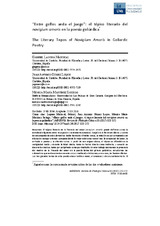“Entre golfos anda el juego”: el tópico literario del navigium amoris en la poesía goliárdica
The Literary Topos of Navigium Amoris in Goliardic Poetry

Ver/
Autor
Laguna Mariscal, Gabriel
Gómez Luque, Juan Antonio
Martínez Sariego, Mónica M.
Editor
Universidad de ValladolidFecha
2017Materia
TópicoTravesía
Amor
Poesía goliárdica
Navigium amoris
Literary topic
Seafaring
Love
Goliardic poetry
METS:
Mostrar el registro METSPREMIS:
Mostrar el registro PREMISMetadatos
Mostrar el registro completo del ítemResumen
El tópico literario de la Travesía del amor (navigium amoris) puede definirse como la
asimilación figurada entre navegación y sentimiento amoroso. Surgió en la literatura clásica y consta
de un conjunto de seis submotivos: doble faceta de Afrodita‐Venus, la relación sexual comparada con
el acto de navegar o remar, comparación de la mujer o del amor con el mar, la tempestad del amor, la
arribada a puerto y la ofrenda votiva. A partir de ese origen clásico, el tópico se difundió en la
Antigüedad tardía y durante la Edad Media, tanto de forma directa como indirecta, y conoció un
desarrollo creativo, tanto por poligénesis como por tradición. En este trabajo rastreamos la presencia
del motivo de la Travesía del amor en la poesía latina del género goliárdico, estudiamos los
submotivos que se documentan en este corpus medieval, e indicamos, en su caso, las fuentes clásicas.
Los tres grandes temas de esta poesía eran el satírico‐moral, el amoroso y el convival‐tabernario. El tópico clásico de la Travesía de amor contribuye sustancialmente a configurar la temática amorosa de
este género medieval. Y, como consecuencia, la poesía goliárdica constituyó un eslabón significativo
en la transmisión y difusión del tópico. The literary topic of love seafaring (navigium amoris) can be defined as the identification or
comparison between love and seafaring. As a topic, it first appeared in Classical literature and
included a set of six motifs: double quality of Aphrodite‐Venus, comparison of sexual relationship to
sailing or rowing, comparison of woman and/or love to sea, the love tempest, arrival to harbour and
votive offering. From this classical origin, the topic spread during Late Antiquity and the Middle Ages,
and it was creatively elaborated on, both by polygenesis and by tradition. This paper surveys the
reception of the love seafaring topic in goliardic poetry; its function and the classical sources are
examined from a comparative point of view. The three main thematic lines of goliardic poetry are the
satirical‐moral criticism, exaltation of love and the convivial invitation. The topic of love seafaring
contributed as a core element to the building of amatory goliardic poetry. As a result, goliardic poetry
was a relevant way to transmit the topic among later poets.
